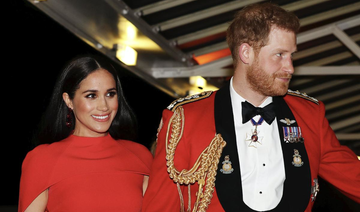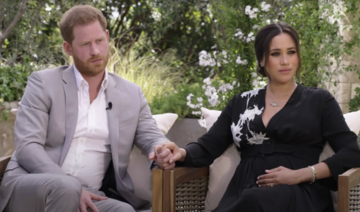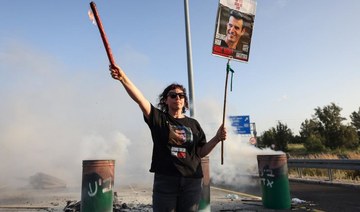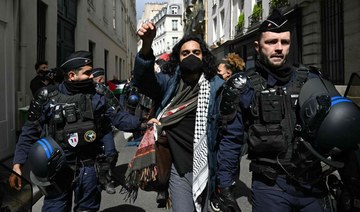LOS ANGELES: In a wide-ranging interview aired Sunday, Harry and Meghan described painful discussions about the color of their son’s skin, losing royal protection and the intense pressures that led the Duchess of Sussex to contemplate suicide.
The interview with Oprah Winfrey was the couple’s first since they stepped down from royal duties and the two-hour special included numerous revelations.
Harry told Winfrey that he felt trapped by royal life and was surprised that he was cut off financially and lost his security last year. He also said he felt his family did not support Meghan, who acknowledged her naivete about royal life before marrying Harry, as she endured media attacks and false stories.
Meghan, who is biracial, described that when she was first pregnant with son Archie, there were “concerns and conversations about how dark his skin might be when he’s born.” The statement led Winfrey to ask “What,” incredulously and sit in silence for a moment.
In a rare positive moment in the interview, Harry and Meghan revealed their second would be a girl. The interview opened with Winfrey gushing over Meghan’s pregnancy and lamenting that COVID-19 protocols kept them from hugging.
The interview aired Sunday night in the United States, a full day before it will air in Britain. The revelations aren’t over: Winfrey teased additional bits of the interview would be shown Monday morning on CBS.
In response to a question from Winfrey, Harry said he wouldn’t have left royal life if he hadn’t married Meghan, but that it was their relationship that revealed the strictures of royal life.
“I wouldn’t have been able to, because I myself was trapped,” Harry said. “I didn’t see a way out.
“I was trapped, but I didn’t know I was trapped,” Harry said, before adding, “My father and my brother, they are trapped.”
Harry acknowledged that he does not have a close relationship presently with his brother William, who is heir to the throne after their father, Prince Charles.
The prince disputed rumors that he intentionally blindsided his grandmother, Queen Elizabeth II, with his decision to split. He suspects the rumors came from the institution.
“I’ve never blindsided my grandmother,” he said. “I have too much respect for her.”
Meghan, too, was complimentary toward the queen, despite saying at one point she realized some in the palace were willing to lie to “protect other members of the family.”
“The queen has always been wonderful to me,” Meghan said.
Winfrey at various points in the interview ran through headlines about Meghan and at one point asked about the mental health impact. Meghan responded that she experienced suicidal thoughts and had sought help through the palace’s human resources department, but was told there was nothing they could do.
Meghan said she grew concerned about her son not having a royal title because it meant he wouldn’t be provided security.
Meghan said digesting everything during while pregnant was “very hard.” More than the “prince” title, she was the most concerned about her son’s safety and protection.
“He needs to be safe,” a teary-eyed Meghan recalled. “We’re not saying don’t make him a prince or princess, whatever it’s going to be. But if you’re saying the title is going to affect their protection, we haven’t created this monster machine around us in terms of click bait and tabloid fodder. You’ve allowed that to happen, which means our son needs to be safe.”
Meghan said it was hard for her to understand why there were concerns within the royal family about her son’s skin color. She said it was hard for her to “compartmentalize” those conversations.
Harry, too, said there are lasting impacts about Meghan’s treatment and his relationship with his family.
“There is a lot to work through there,” Harry said about his relationship with his father. “I feel really let down. He’s been through something similar. He knows what pain feels like. And Archie is his grandson. I will always love him, but there is a lot of hurt that has happened.”
Harry said the royal family cut him off financially at the start of 2020 after announcing plans to step back from his roles. But he was able to afford security for his family because of the money his mother, Princess Diana, left behind.
Sunday’s interview special opened with Meghan describing how naive she was about the ground rules of royal life before she married her husband, Harry, nearly three years ago. “I didn’t fully understand what the job was,” she said. She also noted that she did not know how to curtsy before meeting Queen Elizabeth II for the first time, and didn’t realize it would be necessary.
“I will say I went into it naively because I didn’t grow up knowing much about the royal family,” Meghan said. “It wasn’t something that was part of conversation at home. It wasn’t something that we followed.”
As Meghan Markle, the actor starred in the TV legal drama “Suits.” She married Harry at Windsor Castle in May 2018, and their son, Archie, was born a year later.
Meghan said she and Harry were aligned during their courtship because of their “cause-driven” work. But she did not fully comprehend the pressure of being linked the prestigious royal family.
“It’s easy to have an image of it that is so far from reality,” she said. “And that’s what was really tricky over those past few years, is when the perception and the reality are two very different things. And you’re being judged on the perception, but you’re living the reality of it. There’s a complete misalignment and there’s no way to explain that to people.”
At the top of the interview, Winfrey ran through several key points: that the production was following strict COVID-19 protocols, no topic was off limits and that Meghan and Harry were not being paid for the special.
Royal interviews that aren’t tied to a specific topic are rare, and prior televised sessions have often proved problematic. Prince Andrew’s 2019 BBC interview about his links with convicted sex offender Jeffrey Epstein led to his own departure from royal duties after he failed to show empathy for Epstein’s victims.
Harry and Meghan’s departure from royal duties began in March 2020 over what they described as the intrusions and racist attitudes of the British media toward the duchess.
In Britain, the interview is seen as poorly timed. It will air while Harry’s 99-year-old grandfather Prince Philip remains hospitalized in London after undergoing a heart procedure.
It is unclear what public reaction, if any, the queen and other royal family members will have to Sunday’s interview. The UK’s Sunday Times newspaper, citing an anonymous source, reported that the queen would not watch it.
Meghan and Harry interview with Oprah lays bare royal rift
https://arab.news/6y6s3
Meghan and Harry interview with Oprah lays bare royal rift

- Harry: my father Prince Charles stopped taking my calls
- Interview with Oprah Winfrey follows break with royals
Moroccan photographer Hassan Hajjaj captures the culture of AlUla

- The acclaimed Moroccan photographer discusses his recent show in Saudi Arabia
DUBAI: Early in February this year, Moroccan contemporary artist and photographer Hassan Hajjaj was given a reminder of just how high his star has risen. Within a few days of each other, Hajjaj had shows opening in the US, Morocco, and — as part of AlUla Arts Festival — Saudi Arabia.
Hajjaj’s playful portraiture, which incorporates vivid color, funky clothing (almost all of which he designs himself), geometric patterns, and — often — vintage brands from the MENA region, has made him internationally popular, and his instantly recognizable style has established him as one of the world’s leading photographers.
His show in AlUla consisted of images that he shot in the ancient oasis town in February 2023. That visit was initially supposed to involve shoots with around 20 local people. It’s the kind of thing he’s done a few times before, including in Oman and Abu Dhabi. “It’s always a good opportunity to get to know the culture and the people,” Hajjaj tells Arab News.
But, as he says himself, he arrived in AlUla as “an outsider,” so needed a team on the ground to persuade locals to come and sit (or stand, in most cases) for him.
“It was a bit tough, in the beginning, for them to find people,” Hajjaj explains. “But because it was during a period when lots of art things were happening in AlUla, there were lots of people coming from outside AlUla as well. So we opened it up. I basically said, ‘Just come.’
“In the end lots of people turned up, not just locals — people from Riyadh, Jeddah, and people (from overseas) too. I think I shot around 100 people over a few days. So it was a great opportunity,” he continues. “To get to shoot that many people over three days — organizing something like that for myself might take a year. So, as long as I have the energy, when I get these opportunities — you know, I’m in AlUla with this eclectic bunch of people — I’d rather go and grind it, really work hard, and have that moment.”
A Hassan Hajjaj shoot isn’t your regular portrait shoot, of course. “It’s almost like a performance,” he says. “There’s music, people dress up, it’s like a day out for them, taking them out of themselves for a few hours.”
He followed the same modus operandi in AlUla. “We got an ambience going. It was fun, there was music… I shot in this beautiful old school that was one of the first girls’ schools in Saudi Arabia, from the Sixties. Upstairs was like a museum — everything was like a standstill from the Seventies and Eighties; even the blackboards had the chalk and the writing from that time,” he says.

A crucial part of Hajjaj’s practice is to ensure that his subjects are at ease and feel some connection with him (“comfortable” is a word he uses several times when talking about his shoots). While all his portraits bear his clearly defined style, it’s important to him that they should also show something unique to the people in them.
“It’s that old thing about capturing the spirit of the person in that split second, you know? I’m trying to get their personality and body language in the image,” he says. “Quite often I’m shooting in the street, outdoors, so (the subjects) can start looking at other people, thinking, ‘Are they looking at me?’ So I usually say, ‘Listen. This is a stage I’m building for you. I’m dressing you up, and we’re going to have fun.’ Then I just try and find that personality that can come out and make the image stronger. With some people, though, saying almost nothing can be better — just getting on with it. I try to kind of go invisible so it’s the camera, not the person, that’s doing the work. The best pictures come out when there’s some kind of comfortable moment between me and the person and the camera.”
It’s the way he’s worked since the beginning — a process that developed organically, as most of his early portraits were of “friends or friends of friends.”

“There’s a comfort in that because you have a relationship with them. It made it easy,” he says. “And that taught me about how important it is to build trust with people to get into that comfortable zone. But as time went on, obviously, people could see the stuff in the press or on social media, so then people started, like, asking to be shot in that manner; maybe they’ve studied the poses of certain people and stuff like that, so they come ready to do some pose they’ve seen in my pictures. That’s quite funny.”
The work that was on display over the past two months in Hajjaj’s “AlUla 1445” is a perfect example of what he tries to achieve with his shoots. The images are vibrant, playful, and soulful, and the subjects run from a local goatherder through the AlUla football team to bona fide superstars: the US singer-songwriter Alicia Keys and her husband Swizz Beatz.
Hajjaj says he has a number of favorites “for different reasons,” including the goatherder.

“He brought in two goats and it became quite abstract when you put all of them together. I was playing with that notion of the person; you could see that’s his life and even the goats look happy,” he explains. “I wanted to make sure they had that shine in the image as well. I got some great shots of him.”
The Alicia Keys and Swizz Beatz shoot has been a long time in the making. Hajjaj first met Swizz Beatz a decade ago, and they have been in touch intermittently ever since. The idea of a shoot with Keys first came up about five years ago, but logistics had always got in the way. But since they were playing a concert in AlUla at the same time as Hajjaj was there, it finally happened, on Hajjaj’s last day, with perhaps an hour left before the light faded.
I ask Hajjaj if his approach to shooting celebrities differs from his shots of “ordinary” people.

“There’s probably not that much difference,” he says. “They’re coming into my world, so, again, it’s just making sure they’re comfortable with you and you’re comfortable with them; not looking at them (as celebrities). The only thing is you have to imagine they’ve been shot thousands of times — by top photographers, too — so they’re going to have their ways. So I just have to lock in with them and find that comfortable space between the sitter and me.”
And then there’s Ghadi Al-Sharif.
“It’s a beautiful picture. She’s got this smile, with her hand over her face. For me, that one really presents the light and the energy of AlUla,” Hajjaj says. “It captures the new generation.”
Jessica Seinfeld donates to pro-Israel counter-protests

- Wife of Jerry Seinfeld backs pro-Tel Aviv campaign at UCLA
- Palestine supporters were attacked on the campus Tuesday
DUBAI: American cookbook author Jessica Seinfeld, the wife of comedian Jerry Seinfeld, is backing a pro-Israel counter-protest at the University of California, Los Angeles.
This initiative comes in response to Tuesday night’s outbreak of violence when a group of people assaulted pro-Palestine protestors in their encampment on campus.
Seinfeld highlighted a GoFundMe campaign on her Instagram page and contributed $5,000.
The majority of donations to the fundraiser have been made anonymously. As of Wednesday, the page had accumulated over $93,000.
Seinfeld explained to her Instagram followers that she had donated to the GoFundMe page to “support more rallies” like the ones at UCLA. Encouraging others to do the same, she wrote: “More cities are being planned so please give what you can.”
Billionaire hedge fund manager Bill Ackman, who has previously spoken out about alleged antisemitism at Harvard, contributed $10,000 to a GoFundMe campaign initiated by Nathan Mo from Beverly Hills.
Muslim organizations and students at UCLA have denounced university officials and law enforcement, alleging that they had failed to intervene as students within the pro-Palestinian encampment faced verbal harassment, pepper spray and physical assault.
Ithra showcases Arab creatives at Milan Design Week

- The Dhahran-based cultural center took part in the prestigious Italian fair last month
DUBAI: The King Abdulaziz Center for World Culture (Ithra) participated in Milan Design Week between Apr. 16 and 21. It was the second time Ithra has taken part in the annual event — a significant entry in Italy’s cultural calendar.
Ithra was founded with the goal of developing Saudi creative talent. Noura Alzamil, the center’s head of programs, has seen its influence mushroom since the beginning and continues to be in awe of her country’s rapidly developing art scene.
“Practicing it and seeing it every day around you and reading about it in articles and seeing that interaction and conversation on a national level, is really heartwarming,” she says.

“We’ve been active for the past 13 years, in collaboration with the Ministry of Culture, doing a lot of enriching programs, activations, bringing in new content and experimenting with our community and exposing them to arts, museums theatre, films,” Alzamil adds. “To me, investing in Saudi minds helps them excel in the future. I believe heavily in taking care of young talents, supporting professionals and having a global conversation.”
Ithra also houses what it bills as the region’s first ‘Material Library,’ displaying a variety of raw design materials. “Artists are all about experimentation,” Alzamil says. “The Material Library hosts hundreds of different materials that designers can come and play with.”
A cornerstone of Ithra’s programming is Tanween, a four-day conference that showcases creative designs from university students and emerging creatives from the region. The products from the conference are then exhibited in public events, such as Milan Design Week.

“To me, and to Ithra, it’s really important to showcase our efforts and Saudi and Arab designers in such festivals. Being presented among our peers there is something that we really care about,” says Alzamil. This year, Ithra presented an exhibition of items created by MENA artists in a wide range of mediums in Milan — the first time the center has presented a full show there.
Entitled “From Routes to Roots” and presented in collaboration with Isola (a Milan-based digital platform), the show included glasswork, clay, rugs and lighting. One of the key ideas of the exhibition was to demonstrate how creatives are preserving heritage and the Earth through circular design, which helps to eliminate waste from production.
“They used a lot of integrating bio materials, natural resources, household and industrial waste to come up with these innovative designs and objects that showcase and support sustainability,” Alzamil says.

Participating creatives hailing from the Levant, North Africa and the Gulf included Marwa Samy Studio, Ornamental by Lameice, Joe Bou Abboud, T Sakhi Studio, Bachir Mohamad, Studio Bazazo, and Mina Abouzahra.
“The exhibition draws inspiration and expertise from ancestral culture pairing it with cutting-edge craftsmanship, in a demonstration of how emerging talents can breathe fresh life into the design landscape, bridging the gap between tradition and innovation,” according to a press release.
Lebanese designer Bou Abboud presented a triad of round lighting fixtures that he says pay tribute to old Qatari jewelry, particularly long necklaces.
One of the more delicate pieces on view came courtesy of Jerusalem-based Palestinian designer Lameice Abu Aker. Her light-toned vases, jugs and drinking glasses are fluid and bubbly. She showcased a molecular-looking, violet vase called “Chemistry!” On Instagram, Abu Aker’s brand posted that the piece is “the perfect fusion of art and science, crafted with precision and care by our skilled artisans. Mouth-blown, every curve and line reflects the magic of the chemical reactions that inspired its name.”
Hanging textiles were also noticeably dominant in Ithra’s display. For instance, Doha-based artists Bachir Mohamad and Ahmad Al-Emadi collaborated on geometrical, symbol-heavy, blue-and-white rugs that are an homage to traditional Gulf Sadu weaving, historically practiced by Bedouins.
“It was really exciting,” Alzamil says of the show. “The team received a lot of visitors and different players in the field. . . It’s bridging the gaps between Saudi and international communities.”
London’s Arab Film Club launches podcast focusing on Palestine

DUBAI: The Arab Film Club, a monthly gathering in London celebrating Arab cinema, launched a podcast on May 1.
Spearheaded by the club’s founder, Sarah Agha, an Irish Palestinian actress and writer, the inaugural five-episode season of the interview-based podcast will focus on Palestinian filmmakers and cinema’s role in cultural resistance.
The debut episode features Darin J. Sallam, director of “Farha,” Jordan’s Oscars entry in 2022. In other episodes, Agha interviews Lina Soualem, (“Bye Bye Tiberias”), Ameen Nayfeh (“200 Metres”) Annemarie Jacir (“Wajib”) and Farah Nabulsi (“The Teacher”).

Agha told Arab News, “It is so urgent right now to do anything and everything we can to keep talking about Palestine. So I thought, ‘Why not do some interviews with some of my favorite Palestinian directors and put them online so everyone can listen to them?”
Reflecting on Sallam’s episode, Agha highlighted the transformative potential of cinema. “She is linking educational talks with her film, and I do believe her film is like a tool of change,” the presenter said.
Agha said she found Soualem’s documentary particularly intriguing, due to its departure from the scripted films typically showcased at the Arab Film Club.

“I wanted to make an exception for Soualem’s film because it’s another portrayal of the Nakba, but in very different terrains — like, totally different,” she explained. “My father is from Tiberias, so I was also attracted to it for that reason.”
Agha believes her podcast is launching at a time when Palestinians are being censored in the arts.

“There’s been a lot of cancellations of events to do with Palestine and Palestinian narratives,” she said. “So I think the best thing that we can do is not succumb to hopelessness. The fact that they’re trying to silence voices means those voices are significant. You don’t silence something that’s irrelevant. For example, the fact that the Israeli government tried to pressure Netflix into removing Darin’s film shows that it’s important.”
Agha hopes the podcast will appeal to a diverse audience, including non-Arabs.
“That, for me, is a really big thing. If we just talk to ourselves all the time, we won’t really get any further with reaching a wider audience,” she said.
Saudi Arabia announces Red Sea Fashion Week
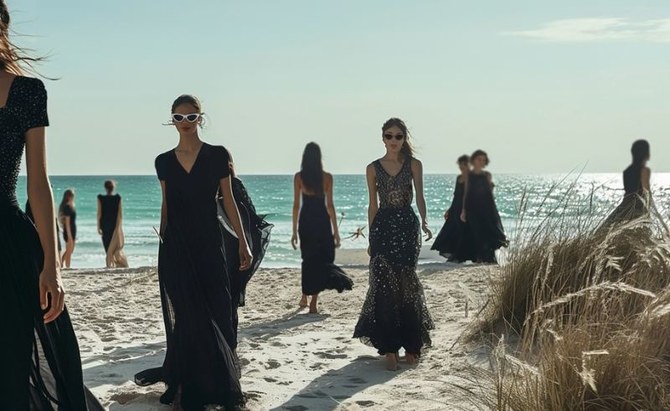
DUBAI: The Kingdom is all set to host the inaugural Red Sea Fashion Week. Set against the waters of Ummahat Island, the glitzy event is scheduled to take place from May 16-18 at The St. Regis Red Sea Resort.
Red Sea Fashion Week, which is organized by the Saudi Fashion Commission, will showcase local and international designers. It aims to celebrate the fusion of traditional Saudi aesthetics with cutting-edge contemporary design.
Among the highlights will be the participation of Saudi 100 Brands, an initiative spearheaded by the Fashion Commission to support and promote emerging local talent.
Saudi Arabia played host to its first fashion week in 2023, in Riyadh. The event took place in the King Abdullah Financial District from Oct. 20-23 and set the stage for a new fashion capital in the Middle East.



